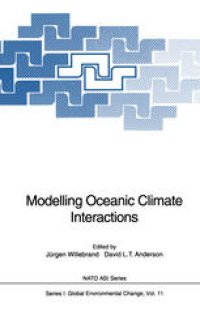
Ebook: Modelling Oceanic Climate Interactions
- Tags: Oceanography, Meteorology/Climatology, Geoecology/Natural Processes, Nature Conservation, Ecology
- Series: NATO ASI Series 11
- Year: 1993
- Publisher: Springer-Verlag Berlin Heidelberg
- Edition: 1
- Language: English
- pdf
The ocean plays a central role in determining the climate of the earth. The oceanic circulation largely controls the temporal evolution of cli mate changes resulting from human activities such as the increase of greenhouse gases in the atmosphere, and also affects the magnitude and regional distribution of those changes. On interannual and longer time scales the ocean is, through its interaction with the atmosphere, a source of important natural climate variations which we are only now beginning to recognise but whose cause has yet to be properly determined. Chem ical and biological processes in the ocean are linked to climate change, particularly through interaction with the global carbon cycle. A quantitative understanding of the oceanic role in the climate system requires models which include many complex processes and interactions, and which are systematically verified with observations. This is the ob jective of global research programs such as TOGA, WOCE, and JGOFS. Coupled numerical models of the oceanic and atmospheric circulation constitute the basis of every climate simulation. Increasingly it is recog nized that in addition a biological/chemical component is necessary to capture the pathways of carbon and other trace gases. The development of such coupled models is a challenging task which needs scientists who must be cognizant of several other disciplines beyond their own specialty.
The ocean plays a central role for the climate of the earth. Storage and transport by the oceanic circulation control the temporal evolution of climate change resulting from the increase of greenhouse gases in the atmosphere, and affect magnitude and regional distribution of those changes.On interannual and longer time scales the ocean is furthermore, through interaction with the atmosphere, a source of important natural climate variability. Chemical and biological processes in the ocean also are strongly coupled to climate change, particularly through the global carbon cycle. This book contains a series of lectures discussing the complex processes and interactions that link the ocean to the climate system, and covers topics from the fields of physical, chemical and biological oceanography as well as meteorology. The focus is on modeling ocean circulation dynamics, hydrological processes in the atmosphere, tropical ocean-atmosphere interactions, and the oceanic carbon cycle.
The ocean plays a central role for the climate of the earth. Storage and transport by the oceanic circulation control the temporal evolution of climate change resulting from the increase of greenhouse gases in the atmosphere, and affect magnitude and regional distribution of those changes.On interannual and longer time scales the ocean is furthermore, through interaction with the atmosphere, a source of important natural climate variability. Chemical and biological processes in the ocean also are strongly coupled to climate change, particularly through the global carbon cycle. This book contains a series of lectures discussing the complex processes and interactions that link the ocean to the climate system, and covers topics from the fields of physical, chemical and biological oceanography as well as meteorology. The focus is on modeling ocean circulation dynamics, hydrological processes in the atmosphere, tropical ocean-atmosphere interactions, and the oceanic carbon cycle.
Content:
Front Matter....Pages I-XIII
The Modelling of Hydrological Processes in the Atmosphere....Pages 1-33
Ocean-Atmosphere Interactions in the Tropics....Pages 35-65
Oceanic General Circulation: Wave and Advection Dynamics....Pages 67-149
On the Oceanic Thermohaline Circulation....Pages 151-183
Parameterizing the Effects of Small-Scale Mixing in Large-Scale Numerical Models....Pages 185-204
Links of the Southern Ocean to the Global Climate....Pages 205-241
Modelling Sea Ice - Mixed Layer Interaction....Pages 243-269
Biochemical Properties of the Oceanic Carbon Cycle....Pages 271-297
The Global Carbon Cycle in the Climate System....Pages 299-336
Ocean Biology, Trace Metals and Climate....Pages 337-371
Modelling Climatic Interactions of the Marine Biota....Pages 373-413
Design of a 3D Biogeochemical Tracer Model for the Ocean....Pages 415-464
Back Matter....Pages 465-472
The ocean plays a central role for the climate of the earth. Storage and transport by the oceanic circulation control the temporal evolution of climate change resulting from the increase of greenhouse gases in the atmosphere, and affect magnitude and regional distribution of those changes.On interannual and longer time scales the ocean is furthermore, through interaction with the atmosphere, a source of important natural climate variability. Chemical and biological processes in the ocean also are strongly coupled to climate change, particularly through the global carbon cycle. This book contains a series of lectures discussing the complex processes and interactions that link the ocean to the climate system, and covers topics from the fields of physical, chemical and biological oceanography as well as meteorology. The focus is on modeling ocean circulation dynamics, hydrological processes in the atmosphere, tropical ocean-atmosphere interactions, and the oceanic carbon cycle.
Content:
Front Matter....Pages I-XIII
The Modelling of Hydrological Processes in the Atmosphere....Pages 1-33
Ocean-Atmosphere Interactions in the Tropics....Pages 35-65
Oceanic General Circulation: Wave and Advection Dynamics....Pages 67-149
On the Oceanic Thermohaline Circulation....Pages 151-183
Parameterizing the Effects of Small-Scale Mixing in Large-Scale Numerical Models....Pages 185-204
Links of the Southern Ocean to the Global Climate....Pages 205-241
Modelling Sea Ice - Mixed Layer Interaction....Pages 243-269
Biochemical Properties of the Oceanic Carbon Cycle....Pages 271-297
The Global Carbon Cycle in the Climate System....Pages 299-336
Ocean Biology, Trace Metals and Climate....Pages 337-371
Modelling Climatic Interactions of the Marine Biota....Pages 373-413
Design of a 3D Biogeochemical Tracer Model for the Ocean....Pages 415-464
Back Matter....Pages 465-472
....